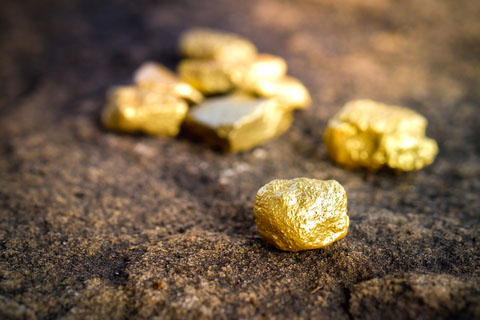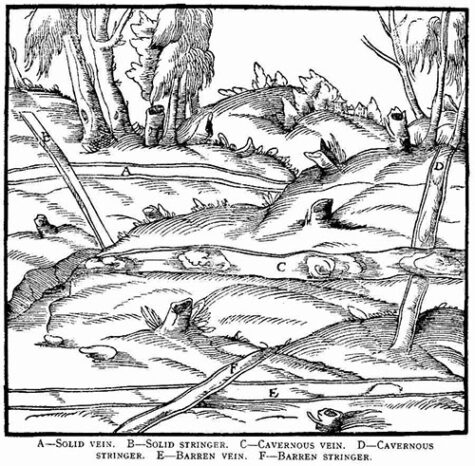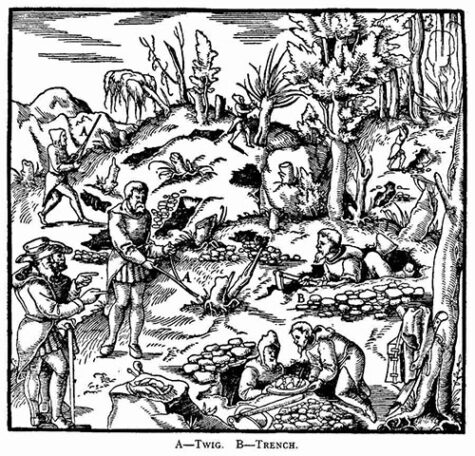
We fantasy fans know this much: mines = dwarves. Short, stocky types with their picks, delving deep beneath the earth. And … er, well, things get a bit fuzzy after that. There’s a ton of details about mining, though, that provide a rich … um … vein to … ah … mine. Yeesh.
Where do precious metals come from?
Without modern understanding of the elements, this is a pretty mysterious question, but that didn’t stop medieval natural philosophers from coming up with ingenious answers.
Like much of medieval understanding of the natural world, we can blame the Greeks, and especially Aristotle (after the 12thc, anyway). Certain core beliefs are relevant here. One, that the earth is a system, usually understood to be a living system in some way or other. Two, that substances are in constant process of growth and change. To stick with mining, raw material becomes base metals which becomes noble metals. Third and finally for our purposes, the celestial affects the terrestrial, right down to the very core of the world.
With that in mind, here are four theories about the formation of noble metals (mostly gold) that I think would be interesting for the fantasy writer.

The World Tree
At the center of the world is a living plant that most writers likened to a tree. Don’t think Yggdrasil or anything so literal; rather, think of it as a principle or concept.
All miners knew that gold appears in two main forms: as dust and grains found in water, and as nuggets found in veins under ground. The veins were as branches of the world tree, growing under the influence of light from stars and planets. That influence ripened the raw, malleable substance into metals base and noble. Some writers said there were male and female principles at work, and there were seeds that could give rise to new branches. The “leaves” shed could be found as nuggets. The dust found in water was the result of the reduction power of water, so that such gold was always purer than was found underground.
The Breathing Beast
A second theory held also that the earth was alive, but that it was more like an animal. The veins found underground were the exhalations of the earth (this provided a convenient explanation for vulcanism, too). As with the branch-and-vine theory, gold was never produced directly but was always the result of forces both celestial and terrestrial.
The Great Albert
Those two ideas both supposed a movement of materials outward toward the surface of the earth. A third theory held “… the place produces things located in that place because of the properties of heaven poured into them by the rays of the stars.” This was from Albertus Magnus. The reason why gold is found as dust and grains is “… the material is subtle [i.e., malleable], and it is driven out and sublimed. Evidence of this is that [gold] is found [that looks] like hardened droplets.” He goes on to point out that larger nuggets of gold appear to be agglomerations of these droplets.
A Natural Growth
A fourth model: gold is produced by solar influence acting on “… a brilliant mercury mixed with a clear and red sulphur, digested and ripened for more than a hundred years….” Silver forms from white mercury and white sulphur, tin by clear mercury and white and clear sulphur, and so on. So, for example, if a mine found only bismuth, cobalt, and zinc, the mining master would declare, “We have come too soon.”
There’s much more but that should be enough to illustrate the point. There was no shortage of ideas on how precious metals formed and, by implication, where to find them.
Prospecting
So, okay. You want to find gold. Where are you going to look? In the back yard? Under the castle? How about out in the wheat field?

Turns out, gold is fairly easy. Look in streams for those tell-tale flakes. Now go upstream until the flakes disappear. The vein is somewhere nearby.
Or, look for outcrops. Erosion can expose rocks that contain gold. Just ask Howard the prospector. That’s from The Treasure of the Sierra Madre, for all you youngsters out there. Earthquakes can do the same work even faster.
Also, that comment about the wheat field wasn’t a joke. We have reports of farmers finding gold because they stumbled over an exceptionally heavy stone while plowing. So, a good deal of prospecting for gold and silver was, for many centuries, done mainly by accident or by just sort of looking around.
Other types of metals can be more difficult to find, which explains the existence and persistent use of things like divining rods to find what is buried.
There’s plenty of evidence that early miners worked top down. That is, at first they looked in and around streams and rivers. This makes sense. Precious items, metals and gems alike, are most likely to be found in places of erosion.
The next logical step was to dig around a little. Then a lot. However much that seemed the payoff would cover the costs of labor and extraction. Mining is always a gamble.
From there, it’s not a stretch to see some of that digging becoming underground mining, with all the appurtenances. At that point, especially, theories about the formation of precious metals became relevant. They gave clues as to where someone might dig with profit.
Next time, I’ll talk about the actual operation of mining, and the various trades and communities that grew out of that. For now, let’s just consider theory and prospecting.
For the Fantasy Writer
All those theories were rather silly, not least because they were grounded (ahem) in some fundamental mistakes. But fantasy writers don’t need to be bothered by that. In fact, such mistakes and theories can be downright inspirational.
Providing magical explanation for the creation of noble metals is fine, and there’s plenty of potential there. Maybe the whole earth isn’t alive, but perhaps there are subterranean beasts whose activity, in combination with other factors and forces, create gold and silver and copper. This could give a whole new direction for dwarven mines.
But there are also magical substances (looking at you, mithril). Surely these ought to have a magical explanation for their existence. Magic should also play a role in prospecting, in the finding of such metals or gems. Hey, maybe divining rods really do work! Who makes those? Do they grow from magical trees?
And yeah, sure, there’s an element called sulphur, but in a fantasy land why not have a red sulphur and a clear sulphur and all the colors of the rainbow sulphur? Why not have different kinds of stones (or metals) that have different magical strengths and weaknesses?
Finally, I can see dwarves sealing up a mine because “we have come too soon,” then someone else (darned humans) deciding to open it up from some other angle. War!
References
There’s an outstanding set of essays on all this. Alas, the website is gone. But the Internet Archive has saved it and it’s to be found on the Wayback Machine. Here’s a link to the historical section:


Interesting. No dwarves in my current world, but there is mining. Had never considered adding a note of mythology to it, but maybe I will. I like the breathing beast concept.
This depends on the definition of Noble Metal. In physics, it’s gold, silver, and copper (filled electron D bands). Most primitive societies would know very little of the expanded noble metals such as rhodium, palladium, ruthenium, osmium, and iridium. And heck, most societies based on medieval times wouldn’t know about most of those, as 1803 is a key date there, with platinum being the earliest if I recall correctly. Not that an advanced smelting culture like dwarves couldn’t learn these things.
When it comes to fantasy, I like the extra creative kick when authors give offbeat explanations for materials and events, it’s much like creation myths in religion, giving the world a unique flavor.
Thanks for the reply, Tigrrl. You are quite right, the article is aimed at fantasy writers, not to SF. The whole series, History for Fantasy Authors, is predicated on the idea that real-world examples are comparatively easy to come by, but non-modern ones require more research. Since I happen to know a bit about the Middle Ages, I offer these essays as a place where fantasy authors can go for ideas or inspiration. Folks can take or leave as it pleases them.
Perhaps I lean toward the literal and the science-based, but my inclination is to not invent new explanations for where gold comes from. Magical methods of mining, sure, go for it, but there is no need to claim that veins of gold are the roots of the World Tree or similar. And no, gold flakes you obtain by panning for gold in a stream are not more pure than gold you find in a vein, necessarily. What is “noble” about gold is that it is soft, malleable, pretty, shiny, easy to mix with other metals, not prone to rust or tarnish, that sort of thing. It was very useful for making pretty things and making things pretty. It is not a special magical quality. Copper is not a noble metal. Although it is fairly soft and easy to work with and makes pretty things, it very quickly oxidizes into crumbly green. In alloys, it is stronger and more resilient, but still has a tendency to tarnish over time. Silver is strongly prone to tarnishing through oxidization. Yes, electrum is a naturally occurring alloy of silver and gold, but it is not the only form one finds gold in nature.
Nice post. There's some lovely ideas in there. I can just imagine a human entering a dwarf mine only to learn that it's actually more of an animal form where the dwarfs are breading all maner of animals who produce these metals. Now that would be a sight to behold.
Of course, I'm blaming phlogiston for all that metal nonsense…